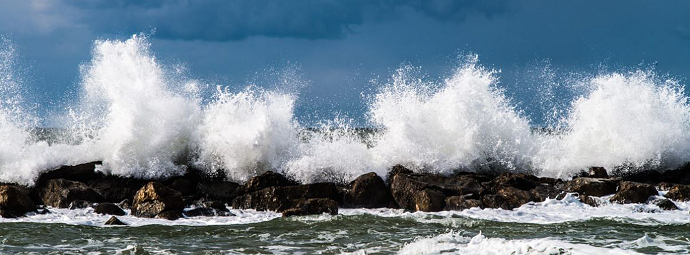Ocean winds and wave heights are becoming more extreme worldwide. Photo by Michael Goyberg.
Ocean winds, wave heights have increased around the world
by Mongabay.com
- An analysis of 33 years’ worth of data finds that ocean winds and wave heights are becoming more extreme worldwide, with the Southern Ocean seeing the largest increases.
- In order to examine long-term trends, Ian Young and Agustinus Ribal of Australia’s University of Melbourne combined nearly 4 billion measurements of wind speeds and wave heights collected from 31 satellite missions between 1985 and 2018 and data from 80 ocean buoys deployed around the globe into a single, extensive dataset.
- The researchers found that there have been small increases in mean wind speed and wave height over the past 33 years, but they found stronger increases in extreme conditions, which they define in the paper as wind speed and wave height measurements that fall in the 90th percentile or above.
An analysis of 33 years’ worth of data finds that ocean winds and wave heights are becoming more extreme worldwide, with the Southern Ocean seeing the largest increases.
In order to examine long-term oceanic trends, Ian Young and Agustinus Ribal of Australia’s University of Melbourne combined nearly 4 billion measurements of wind speeds and wave heights collected by 31 satellite missions between 1985 and 2018 and data from 80 ocean buoys deployed around the globe into a single, extensive dataset. The results of their analysis of that data are detailed in a paper published in Science.
The researchers found that there have been small increases in mean wind speed and wave height over the past 33 years. “There are strong regional variations, with the area of most significant increase in mean wind speed being the Southern Ocean,” they write in the study, adding that they also discovered “weaker positive trends in the equatorial Pacific and North Atlantic Oceans.”
An increase in relatively light winds led to a higher percentage of smaller waves, Young and Ribal determined, but an increase in stronger winds resulted in “only a small increase in the larger waves, probably due to changes in the duration of these stronger winds.” There was, therefore, relatively small changes in mean wave heights around the globe; only the Southern Ocean showed regions of statistically significant increases in mean wave height.
The researchers found stronger increases in extreme conditions, however, which they define in the paper as wind speed and wave height measurements that fall in the 90th percentile or above. In the Southern Ocean, for instance, the increase in 90th percentile winds was matched by an increase in 90th percentile waves: Extreme winds increased by more than 8 percent, or about 1.5 meters per second (nearly 5 feet per second), over the past three decades, while extreme waves increased by 5 percent, or 30 centimeters (11.8 inches). The North Atlantic also saw increases in 90th percentile waves, but, while most of the other regions of Earth’s oceans experienced statistically significant increases in 90th percentile wind speeds over the study period, they did not show significant increases in extreme wave size.
The authors note in the study that furthering our understanding of the global wind and wave climate and how it is changing over time is important for a number of reasons: “For example, ocean waves play a central role in defining the air-water boundary roughness and hence affect the magnitude of fluxes of energy and CO2 between the atmosphere and ocean. Also, breaking wave setup can be an important component of total water level during storms, a factor made even more significant by the rise of sea level which is accompanying a warming of our planet.”
According to Young, more extreme ocean waves and winds could impact rising sea levels — and hence might pose a threat to coastal infrastructure. “Although increases of 5 and 8 percent might not seem like much, if sustained into the future such changes to our climate will have major impacts,” he said in a statement. “Flooding events are caused by storm surge and associated breaking waves. The increased sea level makes these events more serious and more frequent. Increases in wave height, and changes in other properties such as wave direction, will further increase the probability of coastal flooding.”
The researcher added that it’s crucial we improve our understanding of changes in the Southern Ocean because it is the origin of the swell that dominates wave climates in the South Pacific, South Atlantic, and Indian Oceans: “Swells from the Southern Ocean determine the stability of beaches for much of the Southern Hemisphere. These changes have impacts that are felt all over the world. Storm waves can increase coastal erosion, putting coastal settlements and infrastructure at risk.”
CITATION
• Young, I. R. & Ribal, A. (2019). Multi-platform evaluation of global trends in wind speed and wave height. Science. doi:10.1126/science.aav9527
These links are interactive — click on the boxes












